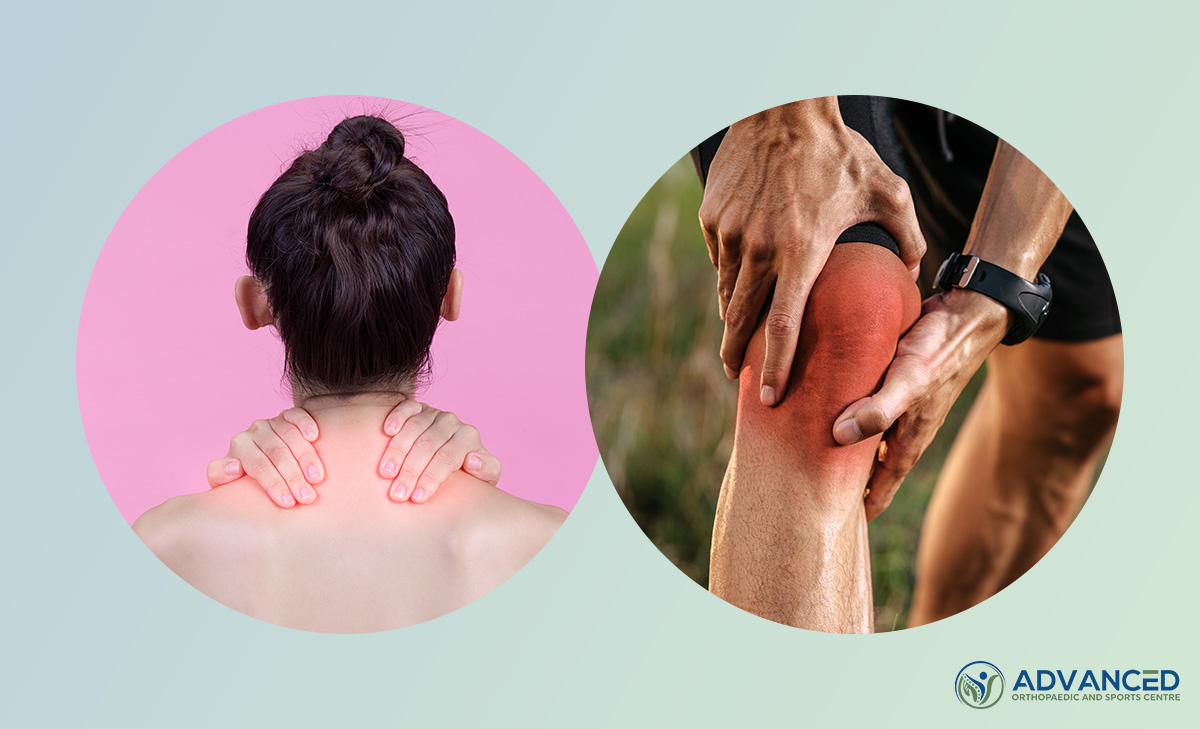When it comes to musculoskeletal health, few areas are as crucial as understanding shoulder and knee injuries. Our shoulders and knees play fundamental roles in our daily lives, enabling us to perform a vast array of movements, from simple tasks like reaching for an object to engaging in athletic endeavours. However, these intricate structures are not immune to injuries, which can occur due to various factors such as overuse, trauma, or age-related wear and tear.
When faced with these injuries, seeking expert advice and treatment becomes important. This is where orthopaedics specialists come into play. These medical professionals possess knowledge and expertise in diagnosing, managing and treating conditions that affect the musculoskeletal system, including the shoulder and knee joints. Be it sports injuries or degenerative conditions like arthritis, these orthopaedic doctors play a role in alleviating pain, restoring function and improving the overall quality of life!
In this comprehensive guide, we will delve deep into the intricacies of shoulder and knee anatomy, exploring their complex structures and functions. You’ll learn all about the common shoulder injuries, their causes, symptoms and the available treatment options, both non-surgical and surgical. Similarly, the most prevalent knee injuries will also be explored, examining their root causes and the diverse array of treatment options.
Whether you are an individual seeking to understand more about shoulder and knee injuries, a sports enthusiast striving to prevent such injuries, or a caregiver providing support to someone experiencing musculoskeletal issues, this blog aims to be your ultimate resource. Let’s get started!
Shoulder Anatomy – Understanding The Structure and Function of the Shoulder Joint
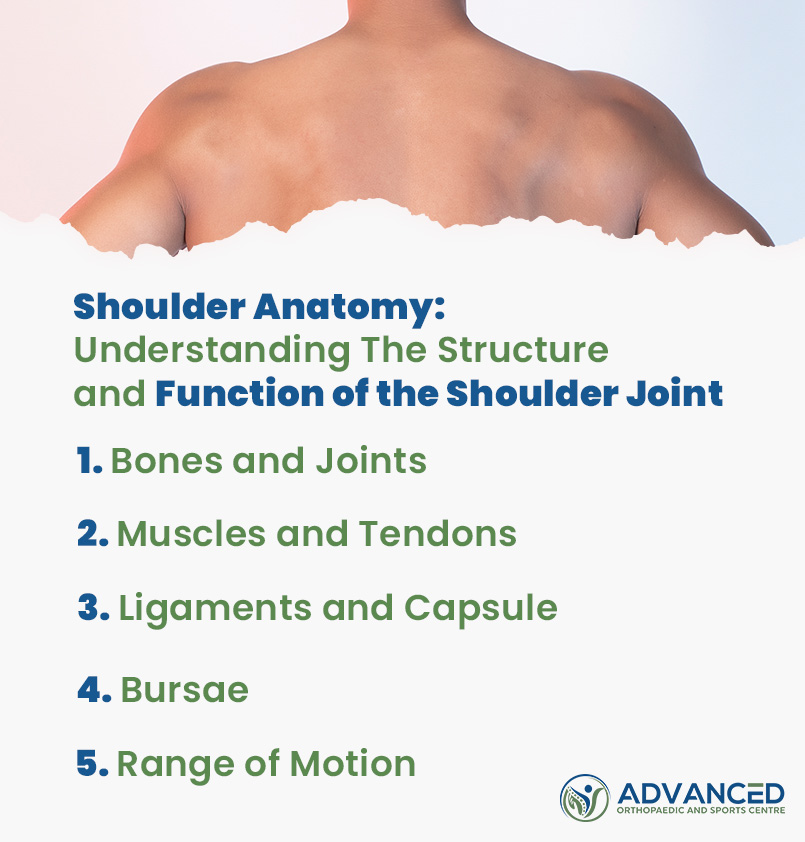
The shoulder joint is a complex and essential part of our musculoskeletal system that allows us to perform a wide range of movements, making it one of the most flexible joints in the human body. To truly understand its significance, let’s explore its detailed anatomy and learn how various components work together to facilitate movement and provide stability.
- Bones and Joints: The shoulder joint is formed by three main bones: the humerus (upper arm bone), scapula (shoulder blade), and clavicle (collarbone). These bones articulate and create two primary joints – the glenohumeral joint and the acromioclavicular (AC) joint. The glenohumeral joint is the ball-and-socket joint that allows for the majority of shoulder movements, while the AC joint supports movements of the shoulder girdle.
- Muscles and Tendons: A network of muscles and tendons surround the shoulder joint, providing the strength and stability necessary for its diverse motions. The rotator cuff muscles – supraspinatus, infraspinatus, teres minor, and subscapularis – work in harmony to control the movement of the humerus within the glenoid cavity, ensuring smooth and controlled motion.
- Ligaments and Capsule: Ligaments are tough bands of connective tissue that reinforce the shoulder joint, preventing excessive movement and maintaining stability. The joint capsule surrounds the joint, containing synovial fluid that lubricates the joint and reduces friction during movements. The capsule’s flexibility permits the shoulder’s extensive range of motion while still providing support.
- Bursae: Small fluid-filled sacs called bursae are located within the shoulder joint, acting as cushions between bones, tendons, and muscles. These bursae reduce friction during movement, preventing irritation and inflammation, especially during repetitive motions or overhead activities.
- Range of Motion: The shoulder joint’s range of motion enables various movements essential for daily activities. Flexion allows us to lift our arms forward, while extension brings them backwards. Abduction involves moving the arms away from the body, and adduction brings them back to the body’s side. Additionally, the shoulder joint’s ability to rotate internally and externally enables us to perform tasks like reaching, throwing, and combing our hair.
The complex anatomy of the shoulder allows for the exceptional range of motion that supports our daily activities and physical endeavours. But it is also susceptible to various injuries that can significantly impact our lives.
Shoulder Injuries: Causes, Symptoms and Treatment Options
Learning and understanding the causes, symptoms, and treatment options for these injuries is crucial for effective management and successful recovery, allowing individuals to regain mobility, alleviate shoulder pain, and resume their regular activities.
1. Rotator Cuff Tears
- Causes: Rotator cuff tears can occur due to repetitive overhead motions, traumatic injuries, ageing, or degenerative conditions. People engaged in sports or professions requiring repetitive arm movements, such as baseball pitchers or painters, are particularly prone to this injury.
- Symptoms: The most common symptoms of a rotator cuff tear include persistent shoulder pain, weakness in the affected arm, and a limited range of motion. Pain is often more pronounced during arm movements, particularly when lifting or reaching overhead.
- Treatment Options: Non-surgical approaches for mild to moderate tears include physical therapy to strengthen the shoulder muscles, medications to manage pain and inflammation, and corticosteroid injections to reduce swelling. In cases where conservative methods are ineffective or the tear is severe, surgical repair may be necessary to reattach the torn tendon to the bone and restore shoulder function.
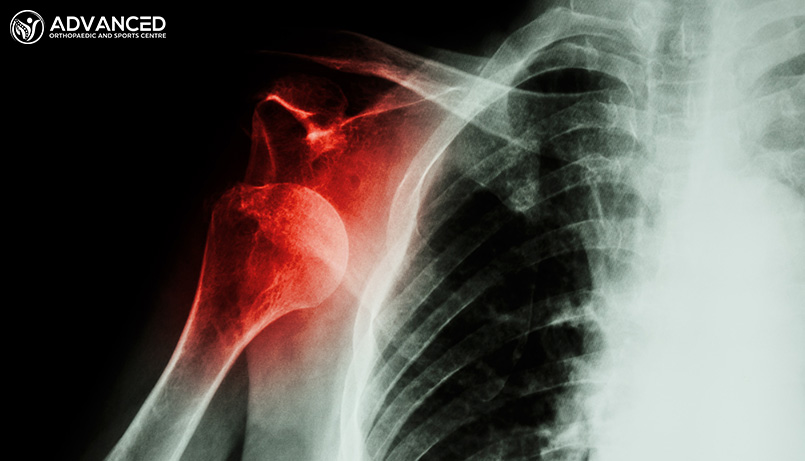
2. Shoulder Dislocation
- Causes: Shoulder dislocations typically result from a sudden impact, falls, or excessive force on the shoulder joint, often seen in contact sports or accidents.
- Symptoms: A dislocated shoulder is characterised by intense pain, visible deformity, and limited mobility of the affected arm. The shoulder may appear out of place, and the individual may experience discomfort or difficulty moving their arm.
- Treatment Options: Immediate treatment involves closed reduction, where a healthcare professional gently manipulates the shoulder joint to place the humeral head back into its socket. After reduction, immobilisation with a sling is usually recommended to allow the joint to heal. Physical therapy helps restore strength and stability, and surgical stabilisation may be considered if dislocations become recurrent.
3. Frozen Shoulder (Adhesive Capsulitis)
- Causes: Frozen shoulder occurs when the shoulder capsule becomes inflamed and thickened, leading to stiffness and reduced range of motion. The exact cause is not always clear, but it can follow a period of shoulder immobility, injury, or conditions like diabetes.
- Symptoms: The condition typically develops gradually and is characterised by persistent pain and stiffness in the shoulder. Daily activities such as reaching for objects or dressing may become challenging due to limited mobility.
- Treatment Options: Non-surgical treatment options focus on relieving pain and restoring motion. Physical therapy, stretching exercises, and heat therapy are commonly prescribed. In more severe cases of frozen shoulders, medication or corticosteroid injections may be used. If conservative methods prove ineffective, manipulation under anaesthesia or arthroscopic surgery may be considered to release the tight shoulder capsule.
4. Shoulder Impingement Syndrome
- Causes: Shoulder impingement syndrome is often caused by overuse, repetitive shoulder motions, poor posture, or structural abnormalities that lead to the compression of the rotator cuff tendons.
- Symptoms: Common symptoms include shoulder pain, especially during overhead movements, weakness, and difficulty lifting objects.
- Treatment Options: Treatment usually begins with rest and activity modification to reduce stress on the shoulder. Physical therapy is employed to strengthen the muscles around the shoulder joint and correct posture. Pain management with medications or corticosteroid injections can provide relief. In refractory cases, surgery may be recommended to create more space within the shoulder joint and alleviate impingement.
5. SLAP Tears (Superior Labrum Anterior to Posterior)
- Causes: Shoulder SLAP tears occur due to traumatic injury, repetitive shoulder motions, dislocation, or degenerative conditions. They affect the superior labrum, the rim of cartilage surrounding the glenoid cavity.
- Symptoms: People with shoulder SLAP tears may experience deep shoulder pain, a catching or popping sensation during movement, and shoulder instability.
- Treatment Options: Non-surgical treatment options include physical therapy, pain management, and activity modification. In some cases, injections may be used to reduce inflammation. If conservative measures are insufficient, surgical repair or reconstruction of the torn labrum may be necessary to reduce symptoms and restore shoulder stability.
Recognising the symptoms and seeking timely treatment from a shoulder specialist is crucial for optimal recovery and the restoration of shoulder function. Whether it is conservative approaches or surgical interventions, a comprehensive and personalised treatment plan can enable individuals to regain their shoulder’s mobility and reclaim an active lifestyle.
Shoulder Treatments: Nonsurgical and Surgical Approaches for Shoulder Conditions
From noninvasive measures like physical therapy and medications to surgical interventions such as arthroscopic surgery or shoulder replacement, each option is tailored to address specific needs and provide the best possible outcome for shoulder health. Let’s delve deeper into the diverse treatment plans available!
1. Physical Therapy
- Description: Physical therapy is a noninvasive treatment approach that focuses on exercises and stretches to improve shoulder strength, flexibility, and range of motion. A qualified physical therapist designs personalised rehabilitation programmes tailored to address the specific needs of each patient.
- Benefits: Physical therapy plays a crucial role in alleviating pain, restoring function, and improving shoulder stability. By strengthening the muscles around the shoulder joint and improving flexibility, physical therapy helps in reducing symptoms and enhancing overall shoulder health.
- Applicable Conditions: Physical therapy is beneficial for a wide range of shoulder conditions, including rotator cuff tears, shoulder impingement syndrome, frozen shoulder, and other injuries or degenerative conditions affecting the shoulder.
2. Medications
- Description: Medications, such as nonsteroidal anti-inflammatory drugs (NSAIDs) and analgesics, are often prescribed to help individuals carry out their daily activities more comfortably.
- Benefits: Medications effectively alleviate pain and reduce inflammation, allowing patients to engage in physical therapy and other rehabilitative measures with greater ease.
- Applicable Conditions: Medications are applicable to various shoulder conditions causing pain and inflammation, including rotator cuff tears, bursitis, and arthritis-related shoulder pain.
3. Injections
- Description: Corticosteroid injections are administered directly into the shoulder joint to significantly improve comfort and mobility.
- Benefits: Injections are especially beneficial for individuals with conditions like rotator cuff tears and arthritis-related shoulder pain. They offer targeted pain relief and reduce inflammation, allowing individuals to participate in physical therapy and other treatments more effectively.
- Applicable Conditions: Injections are commonly recommended for rotator cuff tears, shoulder impingement syndrome, and certain cases of arthritis-related shoulder pain.
4. Arthroscopic Surgery
- Description: Arthroscopic surgery is a minimally invasive surgical procedure used to diagnose and treat various shoulder conditions. Small incisions are made, and a tiny camera called an arthroscope is inserted into the joint, providing a clear view of the internal structures.
- Benefits: Arthroscopic surgery offers several advantages over traditional open surgery, including minimal tissue disruption, faster recovery, and reduced postoperative pain. It allows bone specialists to visualise and repair damaged structures with precision.
- Applicable Conditions: Arthroscopic surgery is suitable for a range of shoulder conditions, such as labral tears, rotator cuff tears, shoulder instability, and certain cases of shoulder impingement.
5. Shoulder Replacement Surgery
- Description: Shoulder replacement surgery is a more involved surgical procedure in which the damaged parts of the shoulder joint are replaced with artificial components. The two main types of shoulder replacement surgery are total shoulder replacement and reverse shoulder replacement.
- Benefits: Shoulder replacement surgery provides pain relief and improves function in individuals with severely damaged or arthritic shoulder joints. It can restore mobility and enhance the overall quality of life.
- Applicable Conditions: Shoulder replacement surgery is typically recommended for severe arthritis, rotator cuff arthropathy (degenerative joint disease associated with a long-standing rotator cuff tear), and certain complex fractures of the shoulder joint.
While conservative methods like physical therapy and medications offer effective relief for milder cases, surgical interventions may be necessary for more severe or advanced conditions. Consulting with a shoulder specialist and undergoing a comprehensive evaluation can help determine the most suitable treatment plan, ultimately leading to improved shoulder health and a return to a more active and pain-free lifestyle.
Knee Anatomy: Exploring The Complex Structure Of The Knee Joint
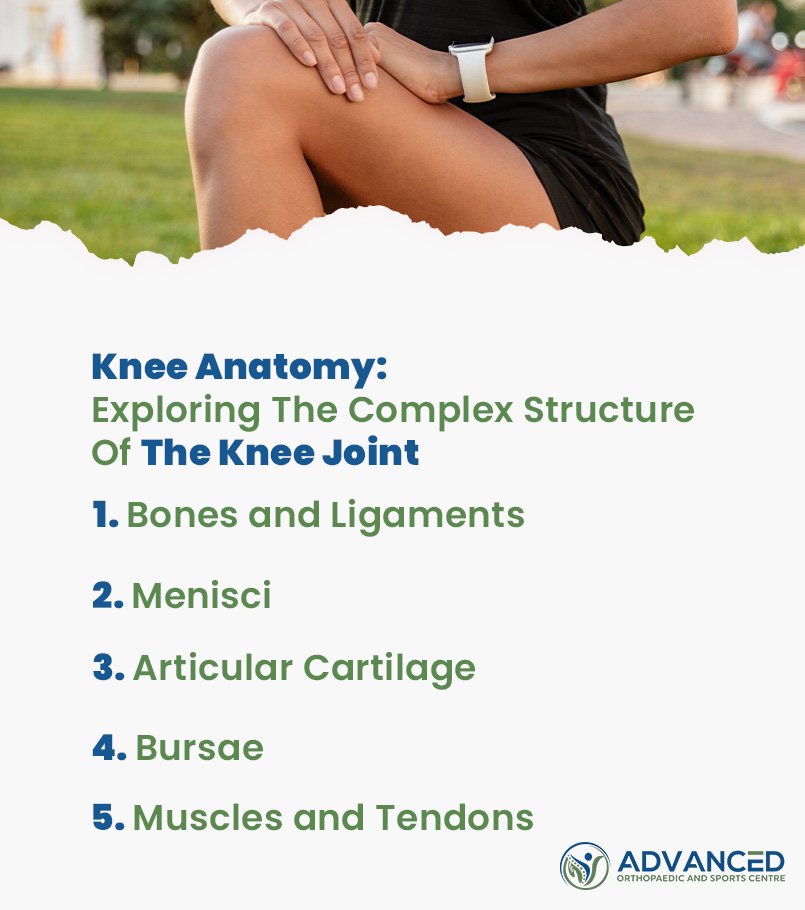
Transitioning from the intricate shoulder joint to another equally crucial joint in the human body, we now delve into the complexities of the knee joint. The knee plays a pivotal role in providing stability, support, and mobility, making it an essential part of our daily activities and physical capabilities. Let’s discover all the different elements that make up the knee joint.
- Bones and Ligaments: At the core of the knee joint lies the interaction between three key bones: the femur (thighbone), tibia (shinbone), and patella (kneecap). These bones come together to form a synovial joint, and their articulating surfaces are protected and reinforced by various ligaments. The anterior cruciate ligament (ACL) and posterior cruciate ligament (PCL) prevent excessive forward and backward movements, respectively, providing vital stability to the joint. On the sides of the knee, the medial collateral ligament (MCL) and lateral collateral ligament (LCL) restrict side-to-side motion, enhancing overall joint integrity.
- Menisci: The knee joint is equipped with two C-shaped pieces of cartilage known as menisci – the medial meniscus and lateral meniscus. These resilient structures serve as shock absorbers between the femur and tibia, cushioning the joint and reducing stress during weight-bearing activities. Their presence enhances the knee’s stability and helps distribute forces evenly across the joint surface.
- Articular Cartilage: To facilitate smooth movement within the knee joint, the ends of the femur, tibia, and patella are covered with a smooth, slippery tissue called articular cartilage. This cartilage allows the bones to glide effortlessly over each other during bending and straightening of the knee. By minimising friction and ensuring smooth articulation, articular cartilage plays a crucial role in maintaining joint health and function.
- Bursae: Surrounding the knee joint are small fluid-filled sacs called bursae. Acting as protective cushions, these sacs reduce friction between tendons, ligaments, and bones during movement. By minimising frictional forces, bursae facilitate smooth, pain-free motion, preventing undue strain on the knee’s delicate structures.
- Muscles and Tendons: A network of muscles and tendons collaboratively supports the knee joint, providing strength and stability. The quadriceps muscles situated in the front of the thigh are responsible for extending the knee, enabling actions like walking, running, and standing up. Conversely, the hamstring muscles located at the back of the thigh flex the knee, allowing activities such as bending the knee or kicking. Connecting the patella to the tibia, the patellar tendon facilitates critical movements, such as jumping and climbing stairs, while ensuring the proper alignment and functioning of the kneecap.
Understanding the anatomy of the knee joint lays the foundation for comprehending the various knee conditions and the treatment option available to maintain its health and functionality.
Common Knee Injuries: Causes, Symptoms, and Treatment Options
The knee, being a crucial weight-bearing joint involved in various physical activities, is susceptible to a range of injuries stemming from trauma, repetitive stress, or degenerative conditions. In order to accurately diagnose and treat these knee conditions, let’s first understand the common injuries, their causes, symptoms and treatment options that are available.
1. Ligament Injuries
- Causes: Ligament injuries often occur due to sudden twisting or direct impact on the knee joint, which is frequently observed during sports activities or accidents. Strains or tears of the ligaments can result in considerable discomfort and instability.
- Symptoms: Individuals with ligament injuries may experience severe knee pain, swelling, joint instability, and difficulty bearing weight on the affected leg. The knee may feel weak and give out during movement.
- Treatment Options: The management of ligament injuries depends on the severity of the injury. Mild to moderate cases may respond well to conservative approaches such as rest, ice, compression, and elevation (RICE), along with physical therapy to strengthen the knee and surrounding muscles. In more severe cases or complete tears, surgical interventions, such as ligament reconstruction or an ACL surgery may be necessary to restore stability and function to the knee.
2. Meniscus Tears
- Causes: Meniscus tears commonly result from forceful twisting or rotating of the knee joint, frequently seen in sports that involve sudden changes in direction or accidents. These tears can cause significant discomfort and hinder smooth knee movement.
- Symptoms: Common symptoms of meniscus tears include knee pain, swelling, stiffness, a locking or catching sensation, and difficulty straightening the leg. The knee may feel unstable, affecting daily activities and sports performance.
- Treatment Options: The treatment for meniscus tears is determined by factors such as the tear’s location, size, and severity. Conservative treatment may involve rest, physical therapy to improve knee strength and stability, and medications to manage pain and inflammation. In cases where conservative measures are ineffective, or the tear is severe, surgical interventions like arthroscopy or meniscectomy may be necessary to repair or remove the torn meniscus and alleviate symptoms.
3. Patellofemoral Syndrome
- Causes: Patellofemoral syndrome often arises due to overuse, muscle imbalances, poor alignment of the kneecap, or structural abnormalities. It commonly affects athletes and individuals engaged in repetitive knee movements.
- Symptoms: Symptoms of patellofemoral syndrome typically include knee pain, especially during activities like climbing stairs, kneeling, or prolonged sitting. The pain may worsen with increased activity.
- Treatment Options: The treatment for patellofemoral syndrome typically involves noninvasive measures. Physical therapy is a primary component to correct muscle imbalances and improve patellar tracking. Strengthening exercises for the quadriceps and hamstrings, as well as activity modifications, pain management techniques, and orthotic devices, may also be recommended to alleviate symptoms and promote knee health.
4. Patellar Tendonitis
- Causes: Patellar tendonitis, also known as jumper’s knee, often results from repetitive stress on the patellar tendon, commonly seen in sports activities that involve jumping or running.
- Symptoms: The condition may manifest with localised pain, swelling, tenderness below the kneecap, and difficulty participating in physical activities that involve knee extension.
- Treatment Options: The initial treatment for patellar tendonitis includes rest, ice, and activity modification to allow the tendon to heal. Physical therapy is vital for strengthening the surrounding muscles and improving knee stability. Nonsteroidal anti-inflammatory drugs (NSAIDs) may be used to manage pain and inflammation. In severe or chronic cases, corticosteroid injections or knee surgery may be considered as a last resort.
5. Bursitis
- Causes: Bursitis of the knee is often caused by repetitive kneeling, direct trauma, overuse, or underlying inflammatory conditions.
- Symptoms: Individuals with knee bursitis may experience knee pain, swelling, warmth, and limited range of motion, particularly when pressure is applied to the affected area.
- Treatment Options: The treatment for knee bursitis involves a combination of rest, ice, compression, and elevation (RICE) to reduce inflammation. Anti-inflammatory medications may be prescribed to alleviate pain and swelling. In more severe cases, aspiration of excess fluid from the bursa or physical therapy to improve knee mechanics and reduce pressure on the bursa may be necessary. In rare cases of persistent bursitis, surgical drainage may be considered.
Early recognition and appropriate treatment of these injuries are vital in promoting optimal recovery and preventing long-term complications. Whether through conservative methods or surgical interventions, a comprehensive approach guided by medical professionals can help individuals regain knee health and restore their active lifestyles.
Knee Treatments: Noninvasive and Surgical Strategies for Knee Conditions
Let’s explore the different treatment options which can be categorised into noninvasive (conservative) approaches and surgical interventions, each tailored to suit the individual’s unique condition and needs.
1. Noninvasive Treatments
- Description: Noninvasive treatments offer conservative approaches to manage knee conditions without resorting to surgery. These methods focus on promoting healing and alleviating symptoms.
- Examples: Noninvasive treatments encompass a variety of options. Rest is often prescribed to allow the knee to recover and reduce stress on the joint. Physical therapy plays a pivotal role, involving exercises to strengthen the surrounding muscles, improve joint stability, and enhance flexibility. Pain medications, such as nonsteroidal anti-inflammatory drugs (NSAIDs) and analgesics, are used to manage discomfort and reduce inflammation. Lifestyle modifications, like avoiding activities that worsen symptoms and using assistive devices such as braces or crutches, are also recommended. Weight management is emphasised to alleviate excess stress on the knee joint. Some individuals find relief through alternative therapies like acupuncture or chiropractic care.
- Benefits: Noninvasive treatments provide several advantages, including being less invasive, carrying fewer risks and complications, and being generally more accessible and cost-effective. Moreover, they can significantly alleviate knee pain, improve overall knee function, and enable individuals to resume their daily activities with greater ease and comfort.
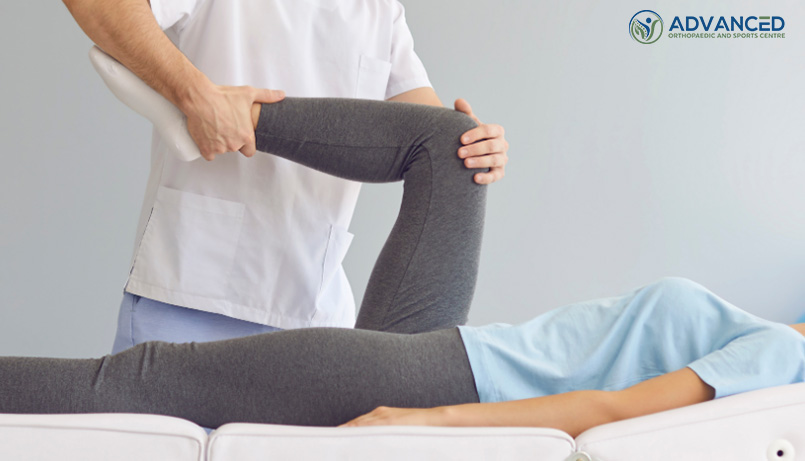
2. Physical Therapy
- Description: Physical therapy is a fundamental component of noninvasive knee treatments, focusing on exercises, stretches, and techniques to strengthen the muscles around the knee joint, improve flexibility, and promote proper alignment and stability.
- Examples: Physical therapy programmes are tailored to suit individual needs and may include specific exercises targeting the quadriceps, hamstrings, and other supporting muscles. Manual therapy, such as joint mobilisation and soft tissue manipulation, can be employed to improve knee function. Additional therapies like electrical stimulation, heat or cold therapy, and hydrotherapy may also be incorporated to aid in pain relief and enhance healing.
- Benefits: Physical therapy plays a crucial role in knee rehabilitation, assisting individuals in regaining strength, flexibility, and range of motion. By focusing on strengthening the supporting muscles, physical therapy helps stabilise the knee joint, reducing the risk of future injuries and improving overall knee function. Moreover, physical therapists also educate patients on proper body mechanics and techniques to prevent further knee problems.
2. Minimally Invasive Procedures
- Description: Minimally invasive procedures occupy an intermediate space between noninvasive treatments and traditional open surgeries, involving small incisions and specialised tools to diagnose and treat knee conditions.
- Examples: Arthroscopy is a common minimally invasive procedure used to examine and treat various knee problems. During arthroscopy, a small camera (arthroscope) is inserted through a small incision, providing real-time images of the knee’s interior. This approach allows knee surgeons to diagnose and repair issues like meniscus tears, ligament injuries, and cartilage damage with minimal tissue disruption and reduced recovery time. Other minimally invasive techniques may include injections of platelet-rich plasma (PRP) or stem cells to promote tissue healing, radiofrequency ablation to target specific nerves for pain relief, or laser therapy to stimulate tissue repair.
- Benefits: Minimally invasive procedures offer several advantages over traditional open surgeries. The smaller incisions result in reduced scarring, less trauma to surrounding tissues, and faster recovery times. Moreover, these procedures often provide effective relief for various knee conditions, allowing individuals to resume their regular activities sooner.
3. Surgical Interventions
- Description: Surgical interventions are typically considered when noninvasive and minimally invasive treatments fail to provide sufficient relief, or when the knee condition is severe or requires structural repair.
- Examples: Surgical procedures for knee conditions may include joint replacement (total or partial), ligament reconstruction (e.g., ACL reconstruction), meniscus repair or removal, cartilage restoration techniques (e.g., microfracture, autologous chondrocyte implantation), or osteotomy (bone realignment) to correct deformities or alignment issues.
- Benefits: Surgical interventions are valuable options for severe or advanced knee conditions where noninvasive and minimally invasive treatments are insufficient. These knee surgery procedures aim to address underlying structural issues, repair damaged tissues, relieve pain, and restore function. For individuals with severe arthritis or irreparable knee injuries, joint replacement surgeries can offer relief, improving their quality of life and mobility.
Knee conditions can range from acute injuries to chronic ailments, impacting individuals of all ages and activity levels. The choice of treatment depends on various factors, including the specific knee condition, its severity, the individual’s overall health, and their desired outcomes. Consulting with a qualified orthopaedic doctor can help determine the most suitable treatment plan, ensuring personalised care to restore knee health and alleviate pain.
Frequently Asked Questions
1. What are the common causes of shoulder injuries?
Shoulder injuries can occur due to various reasons, including falls, repetitive overhead movements, sports activities, direct impact or trauma, and degenerative conditions like osteoarthritis.
2. What are some common treatment options for knee injuries?
Treatment for knee injuries may vary depending on the specific injury. Noninvasive approaches such as rest, physical therapy, medication, and bracing are commonly used. In more severe cases, surgical interventions like arthroscopy, ligament reconstruction, meniscus repair, or joint replacement may be necessary.
3. How long does it take to recover from a shoulder or knee injury?
The recovery time for shoulder and knee injuries can vary depending on the type and severity of the injury, individual factors, and the chosen treatment. Mild injuries may heal within a few weeks, while more severe injuries or surgeries may require several months of rehabilitation for full recovery. It’s essential to follow the healthcare professional’s guidance and adhere to the recommended treatment plan for optimal recovery.
Empower Your Joint Health Today!
Learning and understanding the anatomy of the shoulder and knee joints, common injuries and treatment options can surely come in handy when it comes to effectively managing and maintaining a healthy lifestyle. Shoulder injuries, ranging from rotator cuff tears to shoulder dislocations, can be effectively managed through various approaches, including physical therapy, medications, and minimally invasive procedures. Likewise, knee injuries like ligament tears and patellar tendonitis can be addressed through noninvasive treatments, such as rest, physical therapy, and medications, or may require surgical interventions like arthroscopy or joint replacement for severe cases.
If you are experiencing pain or discomfort in your shoulder or knee area, don’t hesitate to seek professional help. Whether you need a thorough evaluation, conservative treatment, or surgical intervention, our orthopaedic specialists and surgeons are here to guide you towards optimal recovery and improved quality of life. Take the first step towards better joint health by scheduling a consultation with us at Advanced Orthopaedic and Sports Centre today. Your journey to a pain-free and active life starts now.

